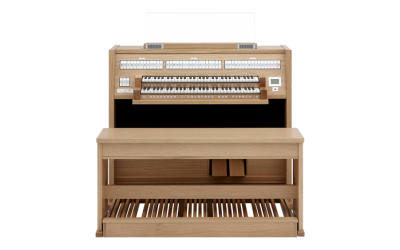Sample set Sonus Paradisi - Warrington Cavaille-Coll Sample Set
Achat immédiat: 446.00 CHF
Description
Aristide Cavaillé-Coll, Warrington organ (1870)
The organ was originally manufactured for the private hall of John Hopwood in Bracewell. The construction of this unusually large orgue de salon took place in the workshop of Aristide Cavaillé-Coll in Paris during 1869-1870. Before shipment to England, the completed organ was erected in Cavaillé-Coll's workshop on Avenue du Maine and the organ builder organized a series of concerts, which were performed by the leading Parisian organists of the time - a notable list containing Camille Saint-Saëns, Charles-Marie Widor, and Alexandre Guilmant.
After arrival in England, the instrument was erected in the rural "cottage" of John Hopwood in November 1870 and voiced there under the direction of Felix Reinburg, Cavaille-Coll's favorite voicer. It occupied a large part of the music room, and was inaugurated by Dr. William Spark of Leeds who gave three concerts there on the 7th-9th November 1870. The organ had 3 manuals and 41 stops, and was one of the first Cavaillé-Coll instruments to have two swell boxes: both the Positif and the Récit are enclosed.
Although this organ is large, especially for an orgue de salon, the voicing is carefully done so as not to overwhelm the listener. The overall design is also notable for the placement of some stops - for example, the Hautbois and Voix Humaine are located on the Positif rather than their usual position on the Récit. Also, it is remarkable that the original design did not have a single aliquot; no Cornet, Nazard, Larigot, or Tierce to be found anywhere. But there is a wealth of foundation stops in varying colors, permitting countless ensembles and orchestral timbres.
Later, Hopwood decided to move the instrument into his new estate in Ketton. The new house was more extensive than Bracewell and the music room was somewhat larger, but the organ still occupied about 1/3 of the room. After the move, the organ was expanded by Cavaillé-Coll himself. It gained a true Subbass 32 (replacing what was before a Resultant), and a Violon 16 and Diapason 8 were also added to the pedal. In addition, a Diapason 8 enriched the stop list of the Récit, and a Dulciana 8 was added to the Positif. However, the pipes of the Dulciana were later replaced for more a delicate English Dulciana, an even softer string demanded by contemporary English music. In 1878, Cavaillé-Coll was commissioned to change the Octave 4 of the G.O. to an Octave 2. Originally, in accordance with Cavaillé-Coll's style, the organ had both a Prestant 4 and an Octave 4 on the G.O.
One year later, the London organ builder Thomas Lewis added two mixtures: an Echo Mixture to the Positif, which is a progressio harmonica of 6 ranks of string timbre (8 + 4 +2 2/3 + 2 + 1 1/3 + 1); and a 6-rank Mixture for the Récit. Both the mixtures are operated from small added windchests and have a separate appel.
With these final changes, the tonal development of the instrument reached its present form. In 1926, after the death of Mr. Hopwood, the organ was moved to a new home in the theatre of Warrington, Parr Hall, where it still resides today. The organ was moved by Henry Willis & Sons, and re-erected without further modifications. The organ was inaugurated by Wilfred Sanderson, and a month later a concert was given by Marcel Dupré.
In 1972, Henry Willis & Sons was commissioned to restore the instrument. But it was not a pure restoration; on this occasion, the Barker lever key actions and the stop mechanical actions were changed to electro-pneumatic action. In addition, because the construction of the mixtures by Lewis allowed individual ranks to be drawn separately, two ranks were used as derived stops (the Larigot 1 1/3 on the Positive, and Nasard 2 2/3 on the Récit). Sometime later these two added stops were suppressed by unknown organ builder, but two wooden flanges remained on the console where the stop knobs had been located. These "blanks" were used when designing the Hauptwerk screens, so the user can draw these two stops by pulling these wooden flanges with no label on them.
The organ is serviced by David Wells Organ Builders of Liverpool today. It has not had any substantial restoration for the last 50 years, and it needs one. The organ is seldomly used by the local community, but it remains fully playable with the exception of several pipes here and there, which had to be derived digitally from the surrounding recorded audio material when the sample set for Hauptwerk was prepared.
The organ is the only remaining work of Cavaillé-Coll in Britain that is in close to original condition. This organ is perfect to fit all French symphonic organ music of 19th century and it may also remind the sound of the concert organ of Palais du Trocadéro, which was inaugurated only a few years later.
1. Grand Orgue C–g3 [a3]
Montre16'
Montre8'
Bourdon8'
Viole de gambe8'
Flute harmonique8'
Salicional8'
Prestant4'
Octave2'
Plein jeu harmoniqueVI
Basson16 '
Trompete8'
Clairon4'
2. Positif (enclosed) C–g3 [a3]
Quintaton16'
Principal8'
Nachthorn8'
Dulciana8'
Unda maris8'
Flute douce4'
Doublette2'
Larigot *1 1/3'
Piccolo1'
Echo mixtureVI
Basson et hautbois8'
Clarinette8'
Voix humaine8'
Tremblant
3. Récit (enclosed) C–g3 [a3]
Diapason8'
Flute travers8'
Quintaton8'
Viole de gambe8'
Voix céleste8'
Viole d'amour4'
Flute octav.4'
Nasard *2 2/3
Tierce **1 3/5
Octavin2'
Mixture VI
Basson [= Cor Anglais]16'
Trompete8'
Clairon4'
Tremblant
Pédale C-f1 [g1]
Soubasse32'
Contrebasse16'
Violon16'
Soubasse16'
Diapason8'
Violoncelle8'
Flute8'
Corni dolci4'
Basson **32'
Bombarde16'
Trompette8'
Clairon4'
* Larigot and Nasard are derived from the mixture ranks.
** Tierce and Basson 32' are digital additions.
Couplers:
Positiv / G.O., Récit / G.O., Récit/Positif, G.O. 16', G.O./Ped., Positif/Ped., Récit/Ped.
Accessories:
Swell pedals for Positif and Récit (operating via the Pedal Matrix in Hauptwerk)
Appels for G.O. anches, plein jeu, positif anches, positif mixture, récit anches, récit mixture, pedal anches.
G.O. sur machine (= G.O. unison off)
Annulation anches for G.O. (affecting only the reeds, not the labial Octave 2')
Effet d'orage.
Vous souhaitez voir ce produit dans notre showroom?
Remplissez simplement ce formulaire et nous prendrons contact avec vous pour convenir d'un rendez-vous !






